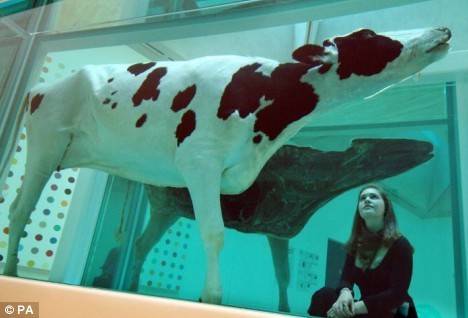
Cross-section anatomical illustration of a pregnant sheep
This got me thinking about Damien Hirst’s ‘Mother and Child Divided’ 1993


And ‘Prodigal Son’ 1994


Very provocative works that broach the big topics: religion / science / violence / ethics / animal welfare / agriculture…
This got me thinking some more about connections between religion and agriculture. An interesting article by organic farmer Robb Waldridge:
“It seems as though food politics is on the verge of becoming religion; if we haven’t already, we’re about to split into sects and factions, driven apart by ideological dogmas that have nothing to do with reality.”
“The result? Each group ends up “preaching to the converted”. Or worse yet, preaching to the choir. A priest who preaches to the choir turns her back on the congregation, the populace, to speak only to those who will sing hymns of praise.”
“In my opinion [a more complete, nuanced understanding] should be a chief goal of all who communicate on food and agricultural issues. Rather than cloistering with the like-minded to codify ideas and thoughts into unchanging dogma so that we can worship it and fight wars over it centuries later, I’d prefer to collaborate with all stakeholders and find opportunities to move forward, to seek understanding, to find solutions to the challenges facing us. Surely, we should be able to expect the same from the leaders of the “food movement.””
Also found this text from 2005: Religion and Agriculture:Sustainability in Christianity andBuddhism, Lindsay Falvey (PDF)
Food production andits science are natural actions that fit into the natural flow, butintentions to gain unnecessary advantage at the expense of-page 195-196
others upsets that natural flow. Ignorance of the natural flow
in no way mitigates the suffering caused by ‘good but ignorant
intentions’. These teachings are clear in Buddhism and just as
in other religions, they are supported by allegories.
The Jataka is a collection of allegories adapted to
Buddhism from pre-existing tales that have separately come
into Western culture as Aesop’s Fables. They portray the
Buddha’s previous lives as moral principles. One example will
suffice. Once upon a time, a goat was led to a temple and was about
to be sacrificed by the presiding Brahman. Suddenly the goat let out
a laugh and then uttered a moaning cry. The Brahman, startled by
this odd behaviour, asked the goat what was happening. The goat
responded as follows: ‘Sir, I have just remembered the history of what
has led to this event. The reason I have laughed is that I realized that
this is the last of 500 births that I have suffered as a goat; in my next
life I will return again as a human. The reason I have cried is out of
compassion for you. You see, 500 births ago I was a Brahman,
leading a goat to the sacrifice. After killing the goat, I was
condemned to 500 births as a goat. If you kill me, you will suffer the
same fate’. The Brahman, visibly shaken, immediately released the
goat, who trotted away. A few minutes later, lightning struck the
goat and he was freed to become a human again. The Brahman
likewise was spared, due to the goat’s compassionate intervention.Set in a time of animal sacrifice, the above tale made
teachings of non-violence more intelligible to the masses. We can argue that it is clearly not intended to be understood
literally in a modern abattoir – but on the other hand, we do
well to ask why in modern societies great effort is invested in
separating killing from meat consumption. At the very least it
places an undue burden for meat animals’ welfare on the very
few who do the dirty work. An intention to minimize the harm
we do in everyday life would highlight this illogicality, which
explains the association of vegetarianism with spiritual
awareness. But vegetarianism is no more an ethic of Buddhism
than it is of Christianity – it appears in the scriptures of both,
as do passages that appear to condone meat consumption.
And in both scriptures, it is the intention and situation of the
act that is the key. Inflexibly following a personal ‘law’ is
anathema to spiritual awareness. In societal terms, however,
there is a benefit from general laws, which in large parts of the
world extend so far beyond Western sensitivities that they are
often dismissed as irrelevant, such as Indian attitudes to cattle
On a side note, I want to look more into this idea of the cow as a sacred figure in Hinduism, after reading elsewhere that ‘cows figure frequently (in the Rig Veda) as symbols of wealth and in comparison with river goddesses’ - a wonderful connection between ancient religious script and NZ’s dairy industry and subsequent river pollution.
!!!!!
I’m also really interested in other aspects Indian culture, especially Ayurvedic concepts regarding the connectedness of diet + lifestyle + physical/mental health.